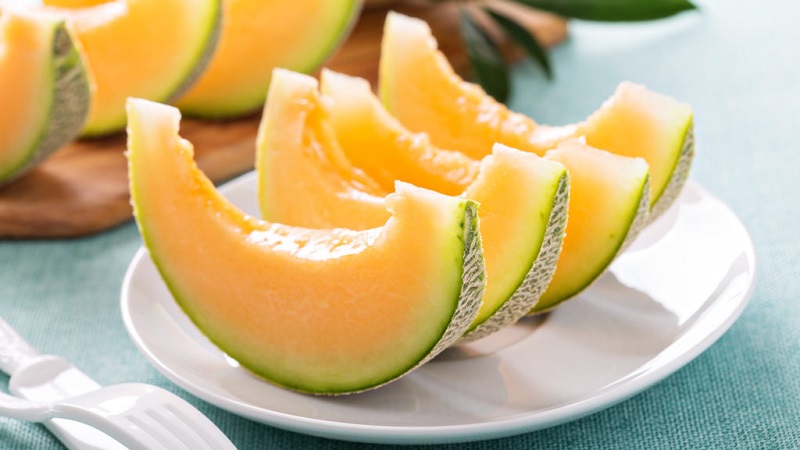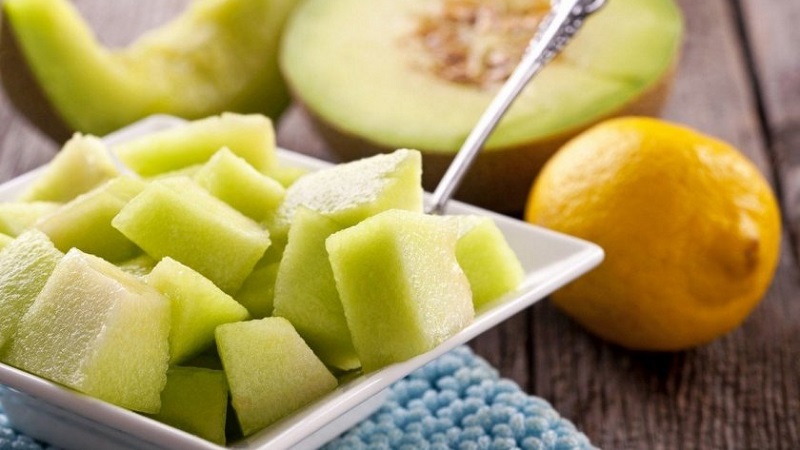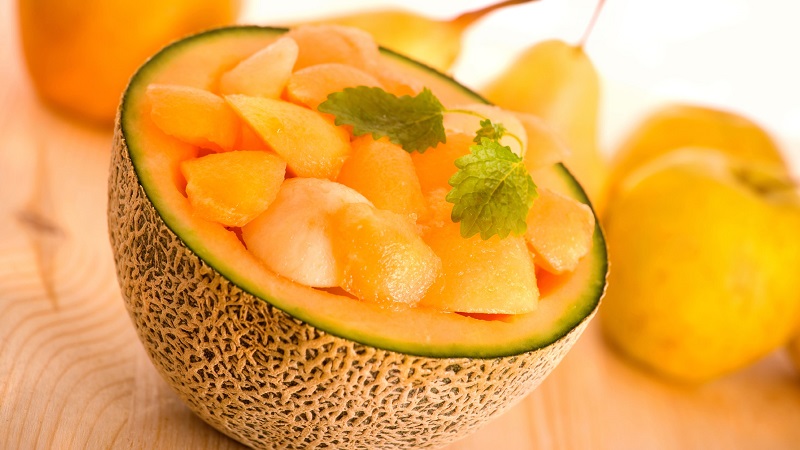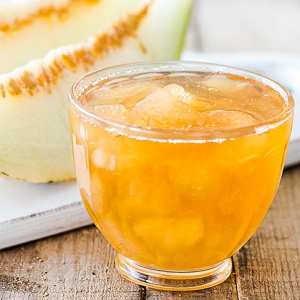Is it possible to eat a melon with pancreatitis of the pancreas
Sweet and tender melon is a tasty and healthy treat. It is rich in fiber, folate, vitamins and antioxidants. All these substances increase immunity, have a beneficial effect on the work of the heart and blood vessels, improve the condition of the hair and improve mood.
But if the norms and rules of consumption are not followed, this fruit causes serious discomfort and eating disorders. People with pancreatic pancreatitis should be especially careful not to aggravate the course of the disease. Under what forms of pancreatitis is melon allowed and in what dosages - read on.
The content of the article
Melon composition
There is a belief that melon is composed only of water and sugar., which means it can be eaten in unlimited quantities. But this is not the case. It contains a wide range of substances that affect the functions of the body.

100 g of melon pulp accounts for:
- calories: 34;
- fat: 0.2 g;
- saturated fat: 0.1 g;
- polyunsaturated fatty acids: 0.1 g;
- monounsaturated fatty acids: 0 g;
- sodium: 16 mg;
- potassium: 267 mg;
- carbohydrates: 8 g;
- fiber: 0.9 g;
- sugar: 8 g;
- proteins: 0.8 g;
- vitamin A: 3% of the acceptable daily intake;
- vitamin C: 30% of the permissible daily intake;
- vitamin B6: 4.5% of the acceptable daily intake;
- folic acid: 4.5% of the acceptable daily intake;
- vitamin K: 3% of the permissible daily intake;
- potassium: 7% of the acceptable daily intake;
- magnesium: 2% of the acceptable daily intake.
Beneficial features
Melon contains compounds that act as antioxidants: beta-carotene, starch, folic acid, potassium, iron, inositol, silicon, phosphorus, magnesium, carotene, organic acids, calcium, vitamins C, PP, B1, B2.
These substances play critical roles in body functions:
- act as a mild laxative;
- fight inflammatory processes;
- have a diuretic effect, due to which they help to remove small stones and sand from the urinary organs;
- participate in the regulation of the water-salt balance in the body;
- have an anthelmintic effect.

Consider properties of individual elements in more detail:
- high content of vitamin C improves immunity;
- silicon has a beneficial effect on the state of blood vessels;
- inosine and vitamin A improve hair condition;
- folic acid stimulates blood formation;
- lycopene and a number of other antioxidants slow down aging, reduce the risk of cancer;
- pectins have an antitoxic effect;
- due to the enzymes contained in the pulp, the breakdown of food substrates is improved;
- nicotinic acid has a beneficial effect on the work of the heart;
- folic acid is involved in the production of the "joy hormone" serotonin and improves mood.
Read also:
Harmful properties
The seeming harmlessness of the melon can mislead many. In some cases, substances that should help the body in work are harmful:
- The high content of coarse vegetable fiber makes melon pulp satisfying. However, its excessive consumption leads to excessive stress on the digestive system. The gastrointestinal tract cannot cope with it, which leads to eating disorders.
- Sorbitol, which is found in melon pulp, can cause severe frothy diarrhea and gas.
- If abused, there is a risk of burns to the mucous membranes of the stomach and intestines.
- Melon is absolutely incompatible with other food products, especially dairy and fermented milk. You can not use drinks with it, even plain water. This is fraught with heaviness, bloating, and diarrhea.
Eating melon for pancreatitis
With a detailed study of the composition of the melon, its benefits are beyond doubt.... But excessive consumption, more than 1.5 kg per day, and combination with other products will cause unpleasant consequences even in a healthy person.
The greatest care should be taken by people with medical conditions. digestive system and inflammatory processes. It is to the latter that pancreatitis belongs, which, according to WHO statistics, now affects 27-50 people per 100,000 of the population.
Pancreatitis is an inflammation of the pancreas... Gastroenterologists distinguish two forms: acute and chronic. After the exacerbation subsides and the expressed symptoms disappear, a period of remission begins.
Important! The role of the pancreas in the functions of the body is great. It participates in the process of digestion, and also regulates the exchange of energy. The enzymes secreted by it depend on how efficiently proteins, fats and carbohydrates will be broken down. Insulin and a number of other hormones secreted by the pancreas regulate blood glucose levels.
The diet for pancreatitis seriously affects the patient's well-being... It is important to carefully choose products, monitor their dosage and method of preparation.

With chronic pancreatitis, the patient is prescribed a therapeutic diet "Table 5"... She prescribes eating sweet fruits and berries, both fresh and dried or dried. Fried, smoked, spicy, sour and fatty foods are prohibited.
Seemingly, melon must be one of the permitted foods... It consists of 90% water, it contains no fats and contains a complex of useful substances. Its pulp is tender, juicy and sweet, which fully corresponds to the characteristics of "Table 5". But there are a number of nuances here.
It can be useful:
The effect of melon on the pancreas
People with pancreatitis cannot always afford to treat themselves to melon.... This is due to the influence of the components of its pulp on the function of the pancreas.
With inflammation of the pancreas, it is necessary to ensure the most gentle mode of its work. That is why gastroenterologists require adherence to the prescribed diet. However when eating melon, everything happens exactly the opposite:
- Even small amounts of melon can stimulate endocrine function. In the stomach, hydrochloric acid begins to be released more actively and the secretory activity of the digestive organs, including the pancreas, increases. Unripe melons are the most dangerous in this regard.
- Melon contains a lot of carbohydrates. They stimulate exocrine function. As the blood sugar rises, the production of insulin rises. Thus, the inflamed organ begins to work even more actively than before, which is unacceptable.
- The abundance of fiber and the presence of simple sugars in the melon provokes fermentation processes in the intestines. This leads to diarrhea, colic, bloating, and flatulence.

Acute pancreatitis
Acute pancreatitis is characterized by the following syndromes:
- attacks of nausea and vomiting (sometimes bile is present in the vomit);
- in the area of the left hypochondrium, there is severe pain;
- temperature increase;
- severe diarrhea;
- blood pressure surges;
- bloating and heaviness in the abdomen;
- the appearance of hemorrhages in the umbilical region.
If you find these symptoms in yourself, you must immediately abandon melon and seek medical attention.
Important! The ban applies not only to the use of pure melon, but also to dishes with it. In the acute phase of pancreatitis, frozen and dried melons, canned melons, mousses and juice are prohibited.
Remission period
 During remission, the symptoms of pancreatitis are either mild or not expressed at all... If the complaints that a person had during the period of exacerbation do not recur, we can talk about persistent remission. Only during this period, patients with pancreatitis are allowed to return the melon to the diet. Before that, it is advisable to consult a gastroenterologist.
During remission, the symptoms of pancreatitis are either mild or not expressed at all... If the complaints that a person had during the period of exacerbation do not recur, we can talk about persistent remission. Only during this period, patients with pancreatitis are allowed to return the melon to the diet. Before that, it is advisable to consult a gastroenterologist.
First, it is better to cook with jelly melon, jams or mousses... Melon juice diluted with warm water is also allowed. It is important to remember that melon is incompatible with other foods, so you cannot add it to salads or use it as a dessert after main courses. Doctors recommend eating a melon at least one hour before the main meal or two hours after.
Choose ripe, dense and aromatic melons when shopping... Useful fruits, the pulp of which has a fibrous structure. An unripe melon will provoke an eating disorder even in a healthy person, therefore, such fruits should not be consumed. It is also advisable not to touch the pulp near the rind itself, but there is only the middle.
Important! At the first signs of exacerbation of pancreatitis, it is necessary to exclude the melon from the diet.
Usage rates
During an exacerbation pancreatitis of the pancreas is strictly prohibited from the use of melons in any form.
When remission occurs you can eat no more than 100 g of pulp at a time. The daily dose is 400 g. With good tolerance, an increase in the dose is permissible, but the maximum possible amount is 1.5 kg per day. Excessive passion for this fruit will overload the digestive system and negate all the benefits.
Conclusion
Melon consumption during pancreatitis mainly depends on the phase of the disease. At the same time, in no case should we forget about moderation and isolated use of melon. Only with strict adherence to the rules of consumption, the melon will reveal all its useful potential and will not harm the body.